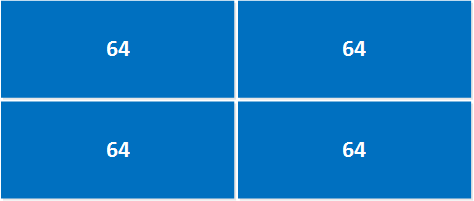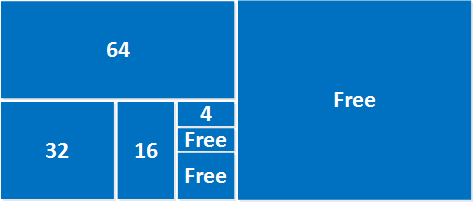In previous subnetting lessons here and here all our subnets had a “fixed size”. Each subnet had the same size. For example we took a class C network 192.168.1.0 and divided it 4 blocks:


Is this really an efficient way of creating subnets? Let’s say I would have the following requirements:
- One subnet for 12 hosts.
- One subnet for 44 hosts.
- One subnet for 2 hosts (point-to-point links are a good example where you only need 2 IP host addresses).
- One subnet for 24 hosts.
I have 4 subnets so it’s no problem, but I’m still wasting a lot of IP addresses. If we use a block of 64 for our subnet where I only need 2 IP addresses I’m throwing 62 IP addresses away.
Now you might think why we could care about this because we are using a private network address (192.168.1.0) and we have plenty of space. This is true, but what about the Internet? We don’t want to throw away valuable public IP addresses.
Let’s say I want to subnet my 192.168.1.0 network in the most efficient way, let’s take another look at the requirements I just showed you:
- One subnet for 12 hosts.
- One subnet for 44 hosts.
- One subnet for 2 hosts.
- One subnet for 24 hosts.
What kind of subnets would we need to fit in these hosts? Let’s see:
- 12 hosts, the smallest subnet would be a block of 16.
- 44 hosts, the smallest subnet would be a block of 64.
- 2 hosts, the smallest subnet would be a block of 4.
- 24 hosts, the smallest subnet would be a block of 32.
Let’s create the subnets. We take our block of “256”:

And chop it into the blocks we just specified:

We just saved ourselves some valuable IP addresses, now the next thing to do is answer the following questions:
- What are the network addresses?
- What are the broadcast addresses?
- What is the subnet mask?
- What are the usable host IP addresses?
Let’s answer these questions. We’ll start with the network addresses:
- Subnet 1: (size of 64)
- network address: 192.168.1.0
- Subnet 2: (size of 32)
- network address: 192.168.1.64
- Subnet 3: (size of 16)
- network address: 192.168.1.96
- Subnet 4: (size of 4)
- network address: 192.168.1.112
- Subnet 5: (this is where the free space starts)
- network address: 192.168.1.116
Now we can fill in the broadcast addresses:
- Subnet 1: (size of 64)
- network address: 192.168.1.0
- broadcast address: 192.168.1.63
- Subnet 2: (size of 32)
- network address: 192.168.1.64
- broadcast address: 192.168.1.95
- Subnet 3: (size of 16)
- network address: 192.168.1.96
- broadcast address: 192.168.1.111
- Subnet 4: (size of 4)
- network address: 192.168.1.112
- broadcast address: 192.168.1.115
Because we have different subnet sizes, we need to calculate the subnet mask for each subnet. To find the subnet mask you can use this trick:
256 – subnet size = subnet mask
- Subnet 1: 256 – 64 = 192 so the subnet mask is 255.255.255.192
- Subnet 2: 256 – 32 = 224 so the subnet mask is 255.255.255.224
- Subnet 3: 256 – 16 = 240 so the subnet mask is 255.255.255.240
- Subnet 4: 256 – 4 = 252 so the subnet mask is 255.255.255.252
The only thing left to do is fill in the usable host IP addresses:
- Subnet 1: (size of 64)
- network address: 192.168.1.0
- first host: 192.168.1.1
- last host: 192.168.1.62
- broadcast address: 192.168.1.63
- Subnet 2: (size of 32)
- network address: 192.168.1.64
- first host: 192.168.1.65
- last host: 192.168.1.94
- broadcast address: 192.168.1.95
- Subnet 3: (size of 16)
- network address: 192.168.1.96
- first host: 192.168.1.97
- last host: 192.168.1.110
- broadcast address: 192.168.1.111
- Subnet 4: (size of 4)
- network address: 192.168.1.112
- first host: 192.168.1.113
- last host: 192.168.1.114
- broadcast address: 192.168.1.115
Here we go, we just subnetted our 192.168.1.0 /24 by using VLSM.
Let’s try another example but this time we use a Class B 172.16.0.0 network with different requirements:
- One subnet for 340 hosts.
- One subnet for 250 hosts.
- One subnet for 31 hosts.
- One subnet for 20 hosts.
- One subnet for 8 hosts.
To solve this question first we need to determine the “block” that we require:



Rene,
A good way to explain this subject that is a little confuse.
About challenge, I tried to solve it…
A network 10.0.0.0
One subnet for 600 hosts -> It’s need a block 1024
One subnet for 250 hosts. -> It’s need a block 256
One subnet for 120 hosts. -> It’s need a block 128
One subnet for 30 hosts. -> It’s need a block 32
One subnet for 2 hosts. -> It’s need a block 4
A block of 1024 is like 4x256, which is need 10 hosts bits.
So…
Subnet 1: (size 1024)
network address: 10.0.0.0/22
... Continue reading in our forumnetmask: 255.255.252.0
first host: 10.0.0.1
last host: 10.0.3.254
broadcast add
Hi Gabriel,
Your example is correct, good job! Also thanks for reporting those errors, just fixed them.
Rene
Rene,
Thanks!!!
Hug
Hi Rene,
Can you pls elaborate on how you got this subnet mask? I didn’t get it. thanks
<>
Sure, which exact subnet mask do you refer to?